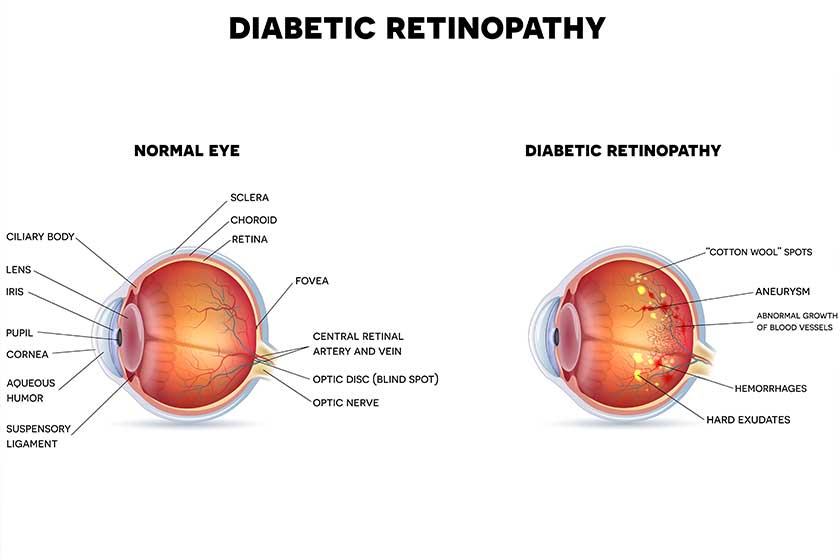Diabetic retinopathy in seniors is a serious eye condition that can lead to vision loss if left untreated. As individuals age, the risk of developing diabetic retinopathy increases, making it essential to recognize the early warning signs and seek timely medical attention. In this blog post, we’ll explore the symptoms of diabetic retinopathy in seniors and emphasize the importance of proactive eye care.
Understanding Diabetic Retinopathy
Diabetic retinopathy is a complication of diabetes that affects the blood vessels in the retina, the light-sensitive tissue at the back of the eye. High levels of blood sugar associated with diabetes can damage the small blood vessels in the retina, leading to various eye problems. As the condition progresses, it can cause vision impairment and, in severe cases, blindness.
In residents with diabetes, the risk of developing diabetic retinopathy is higher due to factors such as prolonged duration of diabetes, poor blood sugar control and other health issues that commonly accompany aging. Understanding the symptoms of diabetic retinopathy is crucial for early detection and intervention to prevent vision loss.
Blurred Vision
One of the earliest signs of diabetic retinopathy in residents is blurred vision, which may occur intermittently or persistently. Blurriness can affect both near and distant vision and may fluctuate in severity throughout the day. Residents may notice difficulty reading, driving, or performing tasks that require clear vision. Blurred vision occurs when fluid leaks into the macula, the central part of the retina responsible for sharp vision, causing it to swell and distort images.
It’s essential not to dismiss blurred vision as a normal age-related change or a temporary inconvenience. Instead, residents with diabetes should promptly report any changes in vision to their healthcare provider for further evaluation and management.
Floaters and Dark Spots
Another common symptom of diabetic retinopathy in seniors is the appearance of floaters and dark spots in the field of vision. Floaters are small, shadowy shapes that drift across the visual field and may resemble specks, dots, or cobwebs. These floaters occur when the vitreous, the gel-like substance inside the eye, shrinks and clumps together, casting shadows on the retina.
Dark spots, also known as “scotomas,” are areas of reduced or absent vision that may appear as patches of darkness or blind spots. These spots can interfere with reading, driving and other daily activities, indicating underlying retinal changes associated with diabetic retinopathy.
Fluctuating Vision
Residents with diabetic retinopathy may experience fluctuations in their vision, with periods of improved clarity followed by sudden blurring or distortion. Fluctuating vision can be particularly frustrating and disruptive, making it challenging to perform tasks consistently and independently.
These fluctuations occur as a result of changes in retinal blood flow and fluid dynamics, which can vary based on factors such as blood sugar levels, blood pressure and overall health status. Monitoring vision changes closely and seeking prompt medical attention can help prevent further vision loss and complications associated with diabetic retinopathy.
Sudden Vision Changes
Residents with diabetic retinopathy may experience sudden and significant changes in their vision, such as a sudden decrease in visual acuity or the onset of new visual disturbances. These changes may occur rapidly and unexpectedly, signaling a progression of the disease or the development of complications such as retinal hemorrhage or retinal detachment.
Residents with diabetes need to be vigilant about monitoring their vision and seeking immediate medical attention if they notice any sudden changes or abnormalities. Prompt intervention can help prevent irreversible damage to the retina and preserve vision to the greatest extent possible.
Reduced Peripheral Vision
Peripheral vision refers to the ability to see objects and movement outside the central field of vision. In diabetic retinopathy, damage to the blood vessels in the retina can lead to a loss of peripheral vision, also known as tunnel vision. Residents may notice a narrowing of their visual field, making perceiving objects or obstacles in their surroundings challenging.
Reduced peripheral vision can impact mobility, balance and safety, increasing the risk of accidents and falls, particularly in older adults. Regular eye examinations and proactive management of diabetic retinopathy are essential for preserving peripheral vision and maintaining independence in daily activities.
Distorted Vision
Distorted vision is a common symptom of advanced diabetic retinopathy, particularly in cases of macular edema or tractional retinal detachment. Residents may perceive straight lines as wavy or distorted, making reading, driving, or recognizing faces difficult. This distortion occurs due to abnormalities in the macula or the pulling of the retina away from its normal position.
Distorted vision can significantly impact quality of life and functional independence, highlighting the importance of early detection and treatment of diabetic retinopathy. Residents experiencing a distortion in their vision should seek immediate evaluation by an eye care specialist to prevent further vision loss.
Get Assistance from Our Retirement Community
We understand residents’ challenges when managing chronic conditions such as diabetic retinopathy. Our community in Mississippi, offers compassionate care and support to residents with vision impairment, ensuring they receive the assistance and accommodations they need to thrive.
Our dedicated team members work closely with residents and their families to develop personalized care plans that address their unique needs and preferences. From assistance with activities of daily living to the coordination of medical appointments and medication management, we provide comprehensive support to enhance the quality of life for every resident.
In addition to our Assisted Living services, we offer specialized memory care for those living with cognitive impairments, including those resulting from diabetic retinopathy. Our SHINE® Memory Care Program utilizes evidence-based interventions and therapeutic activities to promote cognitive function and emotional well-being.
Contact us today to learn more about our senior living options and schedule a tour of our beautiful community. Together, we can navigate the challenges of vision impairment and enjoy a fulfilling lifestyle in Pascagoula, MS. Don’t delay—take proactive steps to preserve your vision and well-being.







